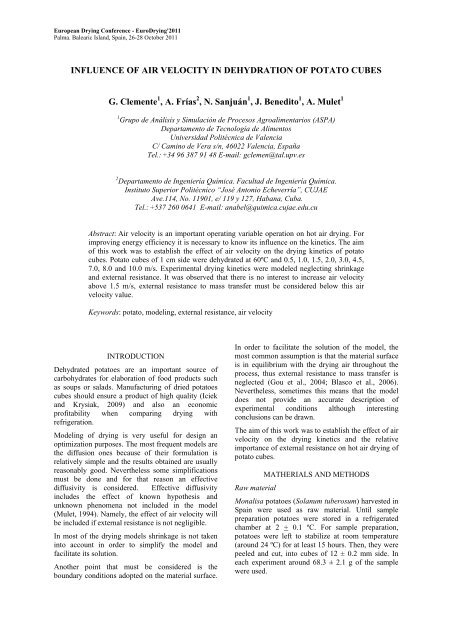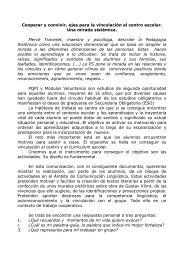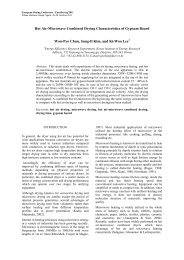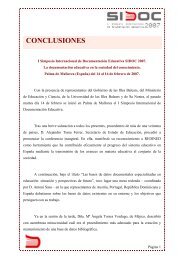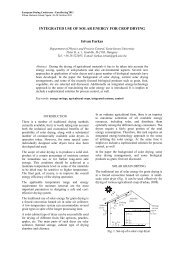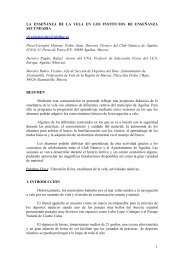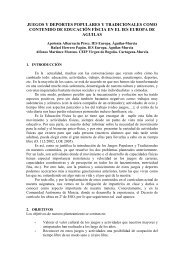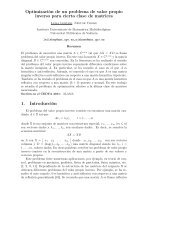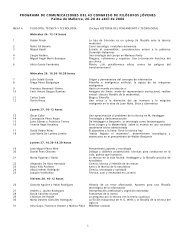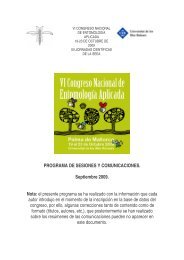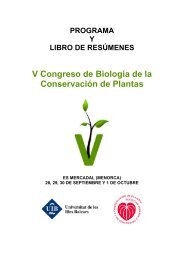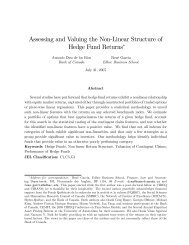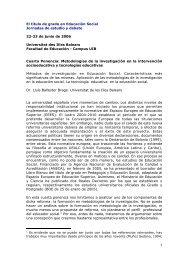INFLUENCE OF AIR VELOCITY IN DEHYDRATION ... - UIB Congres
INFLUENCE OF AIR VELOCITY IN DEHYDRATION ... - UIB Congres
INFLUENCE OF AIR VELOCITY IN DEHYDRATION ... - UIB Congres
You also want an ePaper? Increase the reach of your titles
YUMPU automatically turns print PDFs into web optimized ePapers that Google loves.
European Drying Conference - EuroDrying'2011<br />
Palma. Balearic Island, Spain, 26-28 October 2011<br />
<strong><strong>IN</strong>FLUENCE</strong> <strong>OF</strong> <strong>AIR</strong> <strong>VELOCITY</strong> <strong>IN</strong> <strong>DEHYDRATION</strong> <strong>OF</strong> POTATO CUBES<br />
G. Clemente 1 , A. Frías 2 , N. Sanjuán 1 , J. Benedito 1 , A. Mulet 1<br />
1 Grupo de Análisis y Simulación de Procesos Agroalimentarios (ASPA)<br />
Departamento de Tecnología de Alimentos<br />
Universidad Politécnica de Valencia<br />
C/ Camino de Vera s/n, 46022 Valencia, España<br />
Tel.: +34 96 387 91 48 E-mail: gclemen@tal.upv.es<br />
2 Departamento de Ingeniería Química. Facultad de Ingeniería Química.<br />
Instituto Superior Politécnico “José Antonio Echeverría”, CUJAE<br />
Ave.114, No. 11901, e/ 119 y 127, Habana, Cuba.<br />
Tel.: +537 260 0641 E-mail: anabel@quimica.cujae.edu.cu<br />
Abstract: Air velocity is an important operating variable operation on hot air drying. For<br />
improving energy efficiency it is necessary to know its influence on the kinetics. The aim<br />
of this work was to establish the effect of air velocity on the drying kinetics of potato<br />
cubes. Potato cubes of 1 cm side were dehydrated at 60ºC and 0.5, 1.0, 1.5, 2.0, 3.0, 4.5,<br />
7.0, 8.0 and 10.0 m/s. Experimental drying kinetics were modeled neglecting shrinkage<br />
and external resistance. It was observed that there is no interest to increase air velocity<br />
above 1.5 m/s, external resistance to mass transfer must be considered below this air<br />
velocity value.<br />
Keywords: potato, modeling, external resistance, air velocity<br />
<strong>IN</strong>TRODUCTION<br />
Dehydrated potatoes are an important source of<br />
carbohydrates for elaboration of food products such<br />
as soups or salads. Manufacturing of dried potatoes<br />
cubes should ensure a product of high quality (Iciek<br />
and Krysiak, 2009) and also an economic<br />
profitability when comparing drying with<br />
refrigeration.<br />
Modeling of drying is very useful for design an<br />
optimization purposes. The most frequent models are<br />
the diffusion ones because of their formulation is<br />
relatively simple and the results obtained are usually<br />
reasonably good. Nevertheless some simplifications<br />
must be done and for that reason an effective<br />
diffusivity is considered. Effective diffusivity<br />
includes the effect of known hypothesis and<br />
unknown phenomena not included in the model<br />
(Mulet, 1994). Namely, the effect of air velocity will<br />
be included if external resistance is not negligible.<br />
In most of the drying models shrinkage is not taken<br />
into account in order to simplify the model and<br />
facilitate its solution.<br />
Another point that must be considered is the<br />
boundary conditions adopted on the material surface.<br />
In order to facilitate the solution of the model, the<br />
most common assumption is that the material surface<br />
is in equilibrium with the drying air throughout the<br />
process, thus external resistance to mass transfer is<br />
neglected (Gou et al., 2004; Blasco et al., 2006).<br />
Nevertheless, sometimes this means that the model<br />
does not provide an accurate description of<br />
experimental conditions although interesting<br />
conclusions can be drawn.<br />
The aim of this work was to establish the effect of air<br />
velocity on the drying kinetics and the relative<br />
importance of external resistance on hot air drying of<br />
potato cubes.<br />
MATHERIALS AND METHODS<br />
Raw material<br />
Monalisa potatoes (Solanum tuberosum) harvested in<br />
Spain were used as raw material. Until sample<br />
preparation potatoes were stored in a refrigerated<br />
chamber at 2 + 0.1 ºC. For sample preparation,<br />
potatoes were left to stabilize at room temperature<br />
(around 24 ºC) for at least 15 hours. Then, they were<br />
peeled and cut, into cubes of 12 ± 0.2 mm side. In<br />
each experiment around 68.3 ± 2.1 g of the sample<br />
were used.
Drying experiments<br />
Drying kinetics were determined in triplicate at 60ºC<br />
and 0.5, 1.0, 1.5, 2.0, 3.0, 4.5, 7.0, 8.0 and 10.0 m/s.<br />
For that purpose a laboratory convective dryer,<br />
described in Sanjuán et al. (2003) was used.<br />
The final moisture content of the samples was<br />
determined in triplicate by means of the AOAC<br />
method (AOAC, 1997).<br />
Mathematical modeling<br />
Modeling of the drying process was done considering<br />
that water transport from the centre of solid to the<br />
surface took place mainly by diffusion (Fick’s law).<br />
The model did not consider shrinkage and external<br />
resistance to mass transfer. The model include the<br />
governing equation (equation 1), the initial condition<br />
(equation 2), the symmetry conditions (equations 3, 4<br />
and 5) and the surface boundary conditions<br />
(equations 6, 7 and 8).<br />
∂Xl<br />
∂t<br />
⎛ 2 2 2 ⎞<br />
⎜<br />
∂ X ∂ ∂<br />
= l X<br />
+ l X<br />
D<br />
+ l ⎟<br />
e⎜<br />
2 2 2 ⎟<br />
⎝ ∂x<br />
∂y<br />
∂z<br />
⎠<br />
l (x, y,z,0) X 0<br />
(1)<br />
X = (2)<br />
∂X l (0, y,z, t) = 0<br />
∂x<br />
∂X l<br />
(x,0,z, t) = 0<br />
∂y<br />
∂X l (x, y,0, t) = 0<br />
∂z<br />
l(L,<br />
y,z, t) X e<br />
(3)<br />
(4)<br />
(5)<br />
X = (6)<br />
X = (7)<br />
l(x,<br />
L, z, t) X e<br />
X = (8)<br />
l (x, y, L, t) X e<br />
Equilibrium moisture content (X e ) was obtained by<br />
modeling together different experimental potato<br />
sorption isotherms from literature (Wang y Brennan,<br />
1991; McLaughlin y Magee, 1998; Chou et al., 2000;<br />
McMinn and Magee, 2003) by means of GAB model<br />
with effect of temperature.<br />
The model was solved by means of Separation of<br />
Variables Method. The goodness of fit was evaluated<br />
considering the explained variance (%var).<br />
RESULTS AND DISCUSSION<br />
According to Mulet (1994), when the plot of<br />
(Ψ d(lnΨ)/dt) 2 versus Ψ is a straight line, external<br />
resistance can be considered as non negligible on the<br />
mass transfer process. If external resistance can be<br />
neglected, the plot is a parabola. In Fig. 1, the plot of<br />
(Ψ d(lnΨ)/dt) 2 versus Ψ is represented for all the air<br />
drying velocities considered.<br />
(Ψ d(lnΨ)/dt) 2<br />
0,0000014<br />
0,0000012<br />
0,000001<br />
0,0000008<br />
0,0000006<br />
0,0000004<br />
0,0000002<br />
0<br />
0 0,2 0,4 0,6 0,8 1 1,2<br />
Fig. 1. Plot of (Ψ d(lnΨ)/dt) 2 versus Ψ for the drying<br />
conditions considered<br />
As it can be observed in Fig. 1, for air velocities of<br />
0.5, 1.0 and 1.5 m/s a straight line was obtained. It<br />
seems that for air velocities higher than 1.5 m/s<br />
external resistance to mass transfer can be neglected.<br />
In Table 1 the values obtained for effective<br />
diffusivity are shown. These results are the average<br />
of the three replications. For all drying kinetics<br />
considered, an explained variance higher that 90%<br />
was obtained.<br />
Table 1. Effective diffusivity values and standard<br />
deviation (sd) for air velocity considered.<br />
Ψ<br />
Air velocity (m/s) D e + sd * 10 10 (m 2 /s)<br />
0.5 2.98 + 0.11<br />
1.0 4.35 + 0.09<br />
1.5 6.02 + 0.17<br />
2.0 8.21 + 0.20<br />
3.0 8.28 + 0.32<br />
4.5 8.74 + 0.17<br />
7.0 8.75 + 0.11<br />
8.0 8.72 + 0.14<br />
10.0 8.70 + 0.11<br />
For air velocity 0.5, 1.0 and 1.5 m/s the value of<br />
effective diffusivity is influenced by air velocity.<br />
Nevertheless, for air velocity of 2.0 m/s or higher, the<br />
value of effective diffusivity does not depend on air<br />
velocity. Effective diffusivity is a property which is<br />
linked to a particular product and must not be<br />
influenced by external conditions. If external<br />
resistance is not considered when it is important,<br />
effective diffusivity will be affected because it<br />
includes the effect of this hypothesis (Blasco et al.<br />
2006).<br />
The values in Table 1 are represented in Figure 2.<br />
0.5 m/s<br />
1.0 m/s<br />
1.5 m/s<br />
2.0 m/s<br />
3.0 m/s<br />
4.5 m/s<br />
7.0 m/s<br />
8.0 m/s<br />
10.0 m/s
De (m 2 /s)<br />
1E‐09<br />
9E‐10<br />
8E‐10<br />
7E‐10<br />
6E‐10<br />
5E‐10<br />
4E‐10<br />
3E‐10<br />
2E‐10<br />
1E‐10<br />
0<br />
0 2 4 6 8 10 12<br />
air velocity (m/s)<br />
Fig. 2. Influence of air velocity on effective<br />
diffusivity.<br />
The results shown in Figure 2 and Table 1 are in<br />
agreement with those in Figure 1. For the<br />
experimental conditions in this study, it seems that<br />
external resistance does not influence mass transfer<br />
process for air velocity 2.0 m/s or higher. These<br />
results are in agreement with other authors in<br />
literature (Blasco et al., 2006; Clemente et al., 2011).<br />
These results show that the increase on air velocity<br />
above 2 m/s do not bring an improvement on the<br />
kinetics. As a consequence, 2 m/s seems to be a<br />
threshold from an energy point of view. For air<br />
velocity lower than 2 m/s an optimal air velocity<br />
should be determined considering all the costs<br />
involved.<br />
CONCLUSIONS<br />
During dehydration of potato cubes at 60ºC, external<br />
resistance to mass transfer can be neglected if air<br />
velocity is 2.0 m/s or higher. The results obtained<br />
show that air velocity during drying should be<br />
established to optimize the operation management<br />
increasing also the energy efficiency.<br />
NOMENCLATURE<br />
D e effective diffusivity m 2 s -1<br />
L half-lenght of the cube m<br />
t time s<br />
X e equilibrium moisture content db<br />
X l local moisture content db<br />
x length co-ordinate m<br />
y length co-ordinate m<br />
z length co-ordinate m<br />
Ψ dimensionless moisture content<br />
REFERENCES<br />
AOAC (1997), Official Methods of Analysis.<br />
Washington D.C.: Association of Official<br />
Chemists.<br />
Blasco, M., García-Pérez, J. V., Bon, J., Carreres, J.<br />
E. & Mulet, A. (2006). Effect of blanching and<br />
air flow rate on turmeric drying. Food Science<br />
and Technology International, Vol. 12, pp. 315-<br />
323.<br />
Chou, S.K., Chua, K.J., Mujumdar, A.S., Hawlader<br />
M.N.A. and J.C. Ho (2000), On the intermittent<br />
drying of an agricultural product, Transactions of<br />
the Institution of Chemical Engineers, Vol. 78,<br />
pp. 193-203.<br />
Clemente, G., Bon, J., Sanjuán, N. and A. Mulet<br />
(2011). Drying modelling of defrosted pork meat<br />
under forced convection conditions, Meat<br />
Science, Vol. 88, pp. 374-378.<br />
Gou, P., Comaposada, J. & Arnau, J. (2004).<br />
Moisture diffusivity in the lean tissue of drycured<br />
ham at different process times. Meat<br />
Science, Vol. 67, pp. 203-209.<br />
Iciek, J. and W. Krysiak (2009), Effect of air<br />
parameters on the quality of the dried potato<br />
cubes, Drying Technology, Vol. 27, pp. 1316-<br />
1324.<br />
McLaughlin, C.P. and T.R.A. Magee (1998), The<br />
determination of sorption isotherm and the<br />
isosteric heats of sorption for potatoes, Journal of<br />
Food Engineering, Vol. 35, pp. 267-280.<br />
McMinn, W.A.M. and T.R.A. Magee (2003),<br />
Thermodynamic properties of moisture sorption<br />
of potato, Journal of Food Engineering, Vol. 60,<br />
pp. 157-165.<br />
Mulet, A. (1994), Drying modelling and water<br />
diffusivity in carrots and potatoes, Journal of<br />
Food Engineering, Vol. 22, pp. 329-348.<br />
Sanjuán, N., Lozano, M., García-Pascua,l P. and A.<br />
Mulet (2003) Dehydration kinetics of red pepper<br />
(Capsicum annuum L var Jaranda), Journal of the<br />
Science of Food and Agriculture, Vol. 83, pp.<br />
697-701.<br />
Wang, N. and J.G. Brennan (1991), Moisture<br />
sorption isotherm characteristics of potatoes at<br />
four temperatures, Journal of Food Engineering,<br />
Vol. 14, pp. 269-287.<br />
ACKNOWLEDGEMENTS<br />
The authors acknowledge the financial support of the<br />
Generalitat Valenciana from the project<br />
PROMETEO/2010/062.


